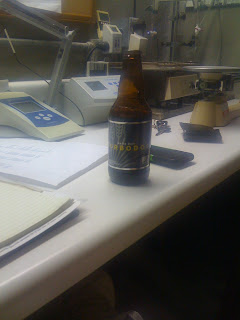We've actually been pretty busy this past week with a big party and lots of work in the winery. Both Stefania and I have been so tired that 9:30 is a late night. Things are going well though and moving along just fine.
Monday we were in the winery to move Chardonnay from tank to barrel. I start fermentation in tank so we can control the temperature better. Cool fermentations mean more peach, pear and fig flavors in the finished wine. The risk is that when fermentations start, they get hot pretty fast and that can lead to tropical fruit flavors I don't want.
Once fermentation gets going the temperatures level out some and we can keep it in the 60 degree range in the barrel. So once the Brix drops to about 15-17 we chill the wine down to 45 degrees and transfer to barrel.
Here's another picture of 'gross lees' as the tank empties and the liquid is gone.

This is the 'baby poop' Stef talks about. We actually want some lees in the barrels so it's a bit tricky to get the juice mixed up in the tank.
 This is how I do it now. Hoses to no where. I hook the pump up to both valves on the tanks. This lets me give the wine a good stir and get the lees even as they go into barrel. Otherwise the last couple of barrels filled up will have all the lees, and we want them to be even in each barrel. I also add a starter for the Malolactic fermentation at this stage. It's a little cool for it at first but our hope is to get both fermentations done together so I can add sulfur to the wine as soon as it goes into the final barrels.
This is how I do it now. Hoses to no where. I hook the pump up to both valves on the tanks. This lets me give the wine a good stir and get the lees even as they go into barrel. Otherwise the last couple of barrels filled up will have all the lees, and we want them to be even in each barrel. I also add a starter for the Malolactic fermentation at this stage. It's a little cool for it at first but our hope is to get both fermentations done together so I can add sulfur to the wine as soon as it goes into the final barrels.Here's an update on our exploding carboy!
This isn't as hard as topping barrels usually is since each barrel will just be filled about 2/3. More than that and the exploding that's been going on in the carboy will happen in barrel and throw 'baby poop' all over the winery.
As fermentation slow and reach the end I'll start moving wine from barrel to barrel, filling up as we go. By the time the wine is done each remaining barrel should be full. For now the CO2 from fermentation is protecting the wine from O2. When fermentation stops though we'll want the barrels totally filled, and then add sulfur to protect the wine from infection.
And here's the traditional cellar works drink:
An Abita Turbodog to get us ready for New Orleans!







No comments:
Post a Comment